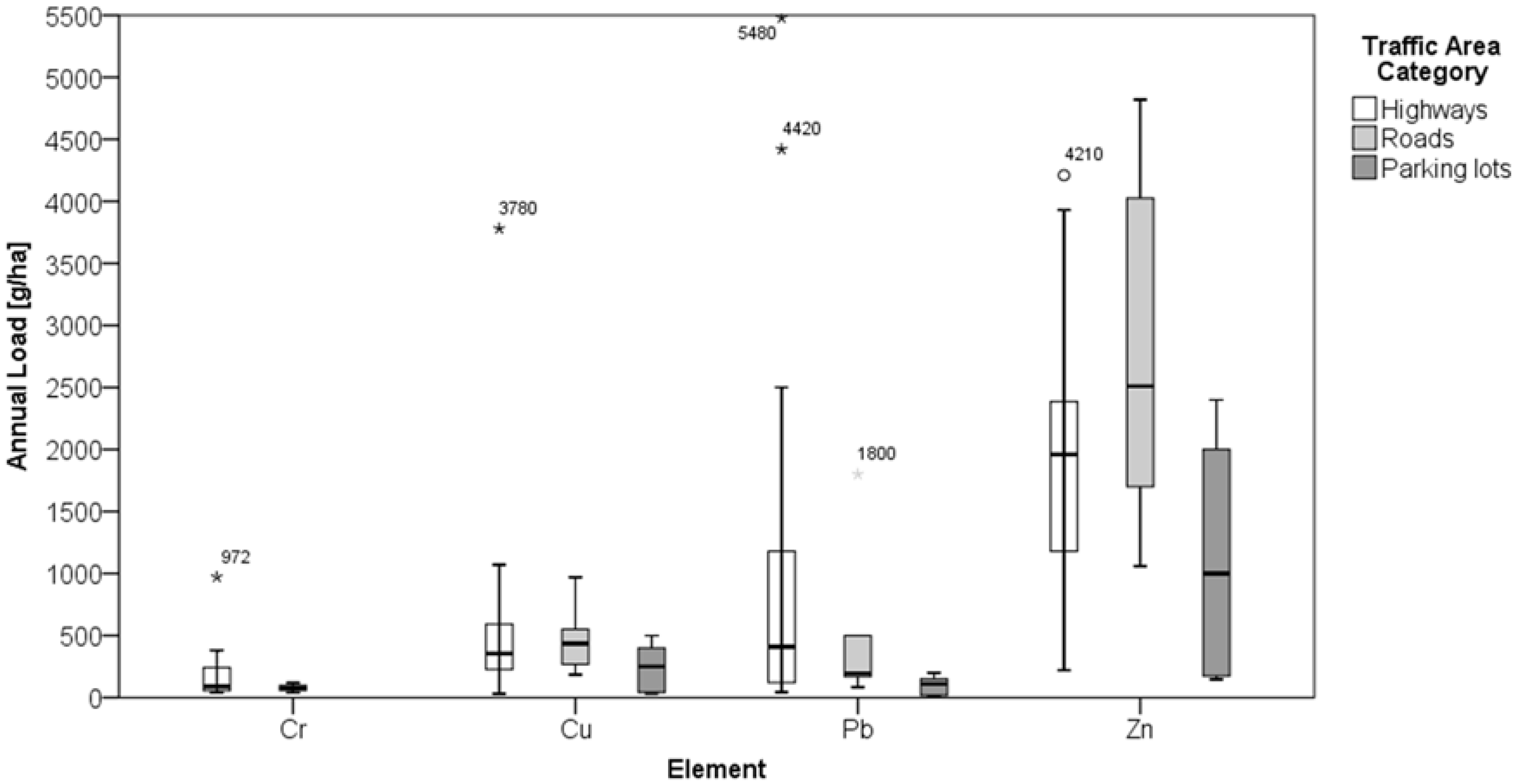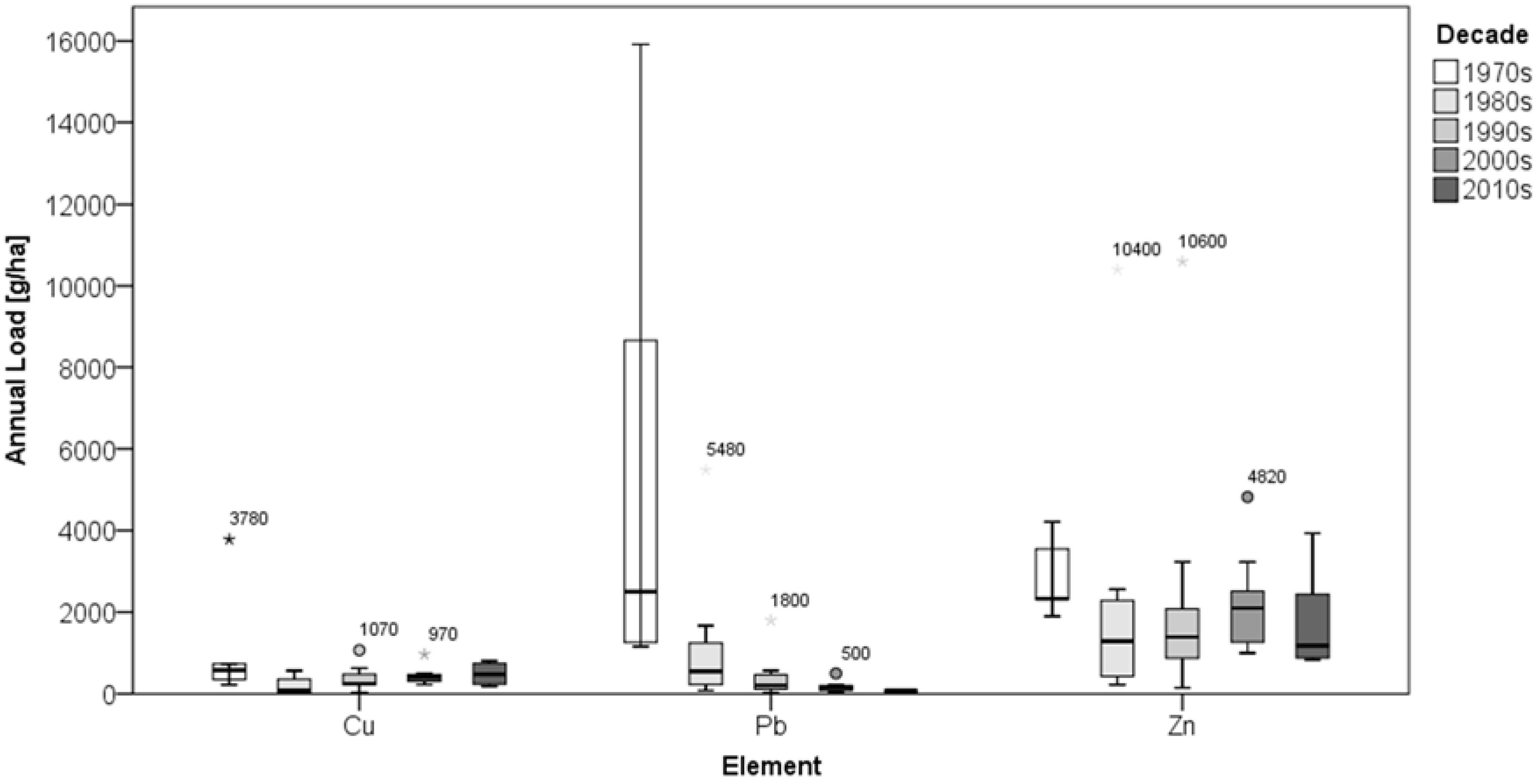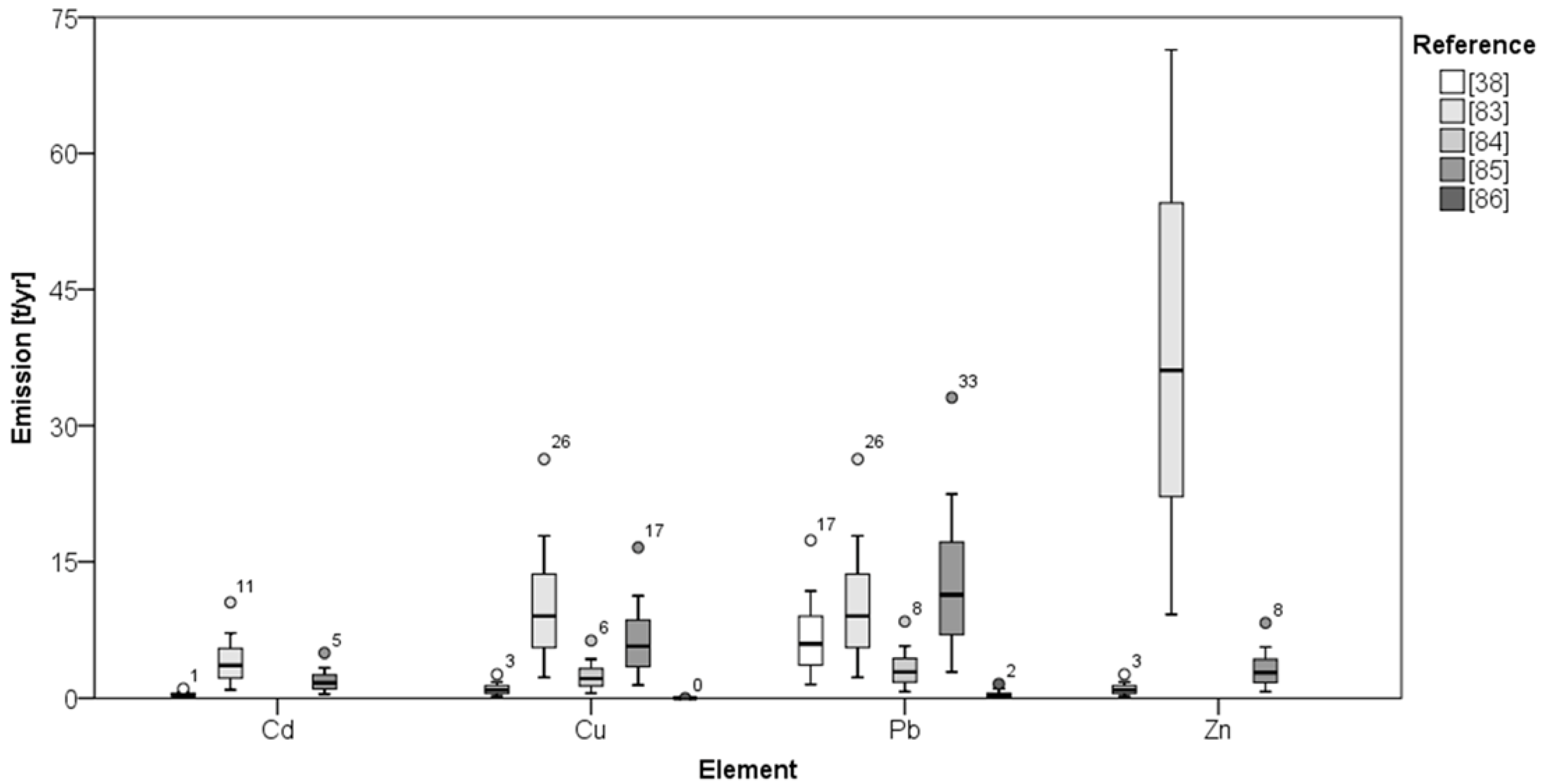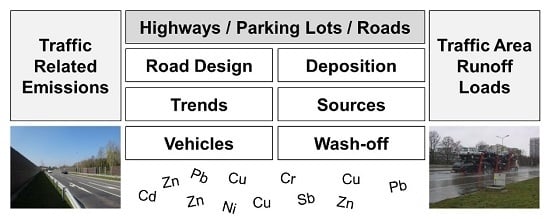3.4.1. Mass Balances of Heavy Metal Traffic Area Runoff Loads
In Germany, there are approximately 281.3 km
2 of highways and 339.5 km
2 of state roads [
78]. The total amount of all types of traffic areas, which also include the areas for railroads, airports, and waterways, is 18,070 km
2 in Germany and the fraction of roads, places (e.g., parking lots and marketplaces), and sidewalks is 15,750 km
2 [
79].
Since median values are preferred for the analyses of such field data [
80], the median annual loads for highway runoff and the area of highways in Germany (281.3 km
2) were used to calculate the total amount of metal loads in runoff from German highways.. These total loads are presented as t/yr (1 t/yr = 1000 kg/yr) and were calculated as approximately 0.38 t/yr Cd, 2.1 t/yr Cr, 9.8 t/yr Cu, 2.5 t/yr Ni, 2.0 t/yr Pb, 0.31 t/yr Sb, and 53.4 t/yr Zn.
The calculated median annual heavy metal loads for all traffic areas, which are similar to the ones for the highway sites, and the total amount of all transportation areas (15,750 km2) were used to estimate the total traffic area runoff loads for Germany. Thus, approximately 10.7 t/yr Cd, 119 t/yr Cr, 558 t/yr Cu, 103 t/yr Ni, 173 t/yr Pb, 22.1 t/yr Sb, and 3087 t/yr Zn are transported by runoff from traffic areas in Germany. Since less polluted traffic areas are also summarized in the total amount of transportation areas and no data are available for these categories regarding runoff loads, the calculated values tend to exaggerate the total runoff loads for Germany.
3.4.2. Mass Balances of Traffic Related Heavy Metal Emissions
Hillenbrand et al. [
81] published heavy metal emission loads of different sources in a literature study for Germany. For the traffic related heavy metal emissions, they calculated the average loads for Cu, Pb, and Zn for the following sources: brake lining wear, tire wear, roadway abrasion, and Pb weights for tire balance. These data were adapted, updated, and extended by Cd and further sources (Zn weights for tire balance guardrails, lampposts/signs, and de-icing salts) for this review. The emission of Pb by leaded gasoline used by classic cars was not considered (only 0.6% of the cars in Germany are classic cars and their kilometric performances are low). A summary of the following results for the four metals Cd, Cu, Pb, and Zn is presented in
Table 7. Both the metal contents of different sources (mg/kg) and the emission rates (mg/(vehicle·km)) are highly variable and only average values for each source are published to indicate their importance in relation to other emission sources.
The first four sources are directly related to vehicles and the loads are determined by multiplying the metal contents of the material by their total abrasion masses. The tire wear was determined by Kocher et al. [
82] based on 62 different tire samples for 13 metals and further substances. Kocher et al. [
82] measured the metal contents of each tire (
n = 62) and the coefficients of variation for the metal contents are 70% for Cd, 38% for Cr, 56% for Cu, 74% for Ni, 95% for Pb, 330% for Sb, and 35% for Zn. This is based on the different ages, manufacturers, and types of tires. The complete mass of tire wear is based on the emission factors reported in seven studies, which determined the tire wear as (mg/(vehicle·km)) for four vehicle categories (summarized in [
81]), and the kilometric performances of the vehicles in Germany. By using the mean metal contents published by Kocher et al. [
82] and an annual mass of tire wear of 111,420 t (coefficient of variation 29%) for Germany, the mean total emission loads for tire wear in Germany were calculated as 0.19 t/yr Cd, 0.51 t/yr Cr, 0.79 t/yr Cu, 0.97 t/yr Ni, 2.03 t/yr Pb, 0.42 t/yr Sb, and 1255 t/yr Zn. In contrast, Hillenbrand et al. [
81] proposed annual emission loads of 2.7 t/yr Pb and 1620 t/yr Zn for tire wear. Thus, the calculated Pb and Zn loads of tire wear differ by approximately 20%–25% between these two studies. A summary of measured metal contents in tires and brakes was also presented by McKenzie et al. [
64]. The contents also have a high variation for each metal (mostly one order of magnitude) and are in the order of the values summarized and measured by the German researchers [
81,
82]. The Cd emission load caused by brake wear was calculated with the metal content of 2.7 mg/kg presented by Legret and Pagotto [
38], which is the median value of the contents summarized by McKenzie et al. [
64] (coefficient of variation 120%), and the total brake lining abrasion mass of 12,500 t/yr published by Hillenbrand et al. [
81]. The loads of brake lining wear for Cu, Pb, and Zn are taken from [
81], which are based on the heavy metal contents of brake linings and their emissions published in eight studies separately for cars and trucks. In Germany, the brake linings of cars were responsible for 83%, 94%, and 80% of the total brake lining emission loads for Cu, Pb, and Zn, respectively. The emissions by weights for tire balances (Pb emissions reduced by 75% because of its substitution, mainly by Zn) and roadway abrasion were adapted from [
81]. The roadway abrasion loads are based on the mean values of 18 road samples. The metal contents of the road surfaces varied between 0.0 and 31.5 mg/kg Cu, 0.9–29.0 mg/kg Pb, and 4–614 mg/kg Zn. Since only few data were available about the wear emission rates, in particular for different types of vehicles (e.g., cars, trucks, and buses), the uncertainties of the emission loads are high. Consequently, more data are needed to calculate reliable tire and break wear loads.
Guardrails, lampposts, and signs are parts of the road design and their heavy metal emissions must also be linked to road transportation [
81]. The Zn emissions of lampposts and signs can only be a rough estimation because the number and surface area of traffic signs and further posts at traffic areas cannot be determined exactly. Most values are based on the assumptions proposed by Hillenbrand et al. [
81].
The traffic related heavy metal emissions by de-icing salts for road maintenance were not previously evaluated for Germany. The novel calculated mean de-icing salt emissions (0.70 t/yr Cd, 1.75 t/yr Cu, 11.6 t/yr Pb, and 1.75 t/yr Zn) are based on an annual consumption of 3.5 million tons in Germany [
78] and heavy metal contents of 0.2 mg/kg for Cd, 0.5 mg/kg for Cu and Zn, and 3.3 mg/kg for Pb in the de-icing salts [
38]. However, these annual de-icing salt emissions are highly variable because of the different metal contents of the salts and the different annual consumptions that strongly depend on climatic factors. According to German regulation, the maximum permitted values for the soluble fraction of de-icing salts in Germany (sodium chloride, calcium chloride, and magnesium chloride) are 2 mg/kg Cd, 5 mg/kg Cu, 5 mg/kg Cr, 5 mg/kg Ni, 5 mg/kg Pb, and 20 mg/kg Zn [
83]. In Great Britain, higher values were measured for a sodium chloride de-icing salt with 4.7 mg/kg Cr, 12 mg/kg Ni, 8.7 mg/kg Pb, and 6.0 mg/kg Zn [
32]. Values of 1.2 mg/kg Cu and 1.6 mg/kg Pb were reported in [
84] for sodium chloride (Cd and Zn not detected). For another sodium chloride de-icing salt, metal contents of 0.94 mg/kg Cd, 1.02 mg/kg Cr, 3.15 mg/kg Cu, 6.29 mg/kg Ni, 6.29 mg/kg Pb, and 1.57 mg/kg Zn were reported by Kobriger and Geinopolos [
85]. Variations of the metal contents for highway de-icing salts were also published by Gupta et al. [
86]: 0.003–0.01 mg/kg for Cr, 0–0.0004 mg/kg for Cu, 0.002–0.003 mg/kg for Ni, and 0.08–0.09 mg/kg for Pb. A comparison of the metal contents in de-icing salts with the ones measured in cooking salts [
87] confirms that these small impurities can occur in all salts used in large quantities. Nevertheless, the total emission loads can be high because of the large amounts of salts used in Germany per year.
The total emissions are influenced by the highly variable annual consumption in Germany (0.46–5.26 million tons per year for the years 1990–2013). The metal contents of Cd, Cu, Pb, and Zn published in five references were multiplied by the annual consumption values in Germany for the years 1990–2013 (
Table 8 and
Figure 3). Each box and whisker represents the annual variation of the heavy metal emissions by de-icing salts for one element and the metal content of the corresponding reference. Thus, the mean de-icing salt emissions presented in
Table 7 can only be a very rough estimation. In contrast to the other traffic related emission sources, the variability of these emissions mainly depends on climatic factors.
For the year 2013 (year 2000 in brackets), the German Federal Environment Agency published national total annual emissions for road transportation as 0.78 (0.82) t Cd, 25.7 (25.1) t Cr, 2109 (1986) t Cu, 5.0 (4.7) t Ni, 88.7 (80.8) t Pb, and 1906 (1805) t Zn [
88]. There is a slight increase of the emissions for five of the six heavy metals in the 21st century. In 2013, the percentages of the traffic related emissions based on the total emissions are 11% for Cd, 45% for Cr, 98% for Cu, 5% for Ni, 42% for Pb, and 95% for Zn. Considering these data, road transportation is an important source of total heavy metal emissions in Germany. With the exception of the data for Cu, these values are comparable with the ones presented in
Table 7. Denier van der Gon et al. [
89] presented annual road transportation emissions for Germany for the year 2000 of 0.88 t Cd, 4.0 t Cr, 102.9 t Cu, 5.0 t Ni, 0.40 t Pb, and 209.8 t Zn. Most of these emission values are lower than the ones proposed by Hillenbrand et al. [
81], calculated in this study, and published by Umweltbundesamt [
88]. These differences are quite high and this is not only related to the variability of the data but also to the fact that each study considers different traffic related sources, which can also vary because of substitutions.
3.4.3. Transportation of Traffic Related Heavy Metals
A sustainable stormwater management combines the stormwater source control and the treatment of traffic area runoff loads to reduce the impact of heavy metals on receiving waters. Therefore, the influence of the traffic related heavy metal emissions on the runoff loads because of leaded gasoline, tire wear, brake lining wear, roadway abrasion, weights for tire balance, guardrails, lampposts/signs, and de-icing salts must also be considered to identify cost efficient mitigation strategies. This process was successfully implemented by the phase-out of Pb in recent decades (cf.
Section 3.2.2). Nevertheless, not all traffic related emissions are found in the runoff because of wind turbulences, vehicles (traffic volume and vehicle speed), antecedent dry periods, and other site-specific factors (e.g., particle size distribution, land use, road surface roughness, or elevated configuration of the traffic area; [
69]). For example, Hallberg et al. [
90] found out that splashing corresponds with the average vehicle speed during storms. In Great Britain, Harrison et al. [
91] measured that 90% of Pb emissions from fast-moving vehicles are deposited away from the immediate vicinity of a non-urban highway (up to several hundred meters). Consequently, most of the emitted Pb was not measured in the runoff. In contrast to Pb, Harrison and Johnston [
92] showed that the Cd and Cu deposition fluxes were elevated close to the investigated highway section and decreased to background levels within 20–40 m. Langbein et al. [
14] and Steiner et al. [
93] measured the different fluxes of Cd, Cr, Cu, Pb, and Zn emissions at a non-urban road with approximately 17,000 vehicles per day in Switzerland (average vehicle speed between 60 km/h and 80 km/h). They evaluated that 17%–25% of the heavy metals were found in the runoff, 21%–38% in the splash water, 19%–45% were blown away and deposited in a distance of up to 25 m away from the road, and 17%–37% were deposited far away (>25 m). Thus, only some heavy metals were found in the runoff of a non-urban road and the fluxes of the emitted heavy metals varied between each element. Legret and Pagotto [
38] calculated emission fluxes and estimated the percentages of Cd, Cu, Pb, and Zn that were removed by runoff waters. The following were considered as emission sources: tire and brake wear, gasoline, safety fences, de-icing salts, and atmospheric deposition (wet and dry). At the investigated rural highway bridge, 313% of the emitted Cd, 2% of Cu, 5% of Pb, and 37% of Zn were found in the runoff water and the rest was dispersed into the atmosphere as dust. For Cd, the authors assumed that some sources might be unrealized or underestimated. Hewitt and Rashed [
94] also measured that the largest part of Pb (approximately 86%) was dispersed in the atmosphere. Most of these mass fluxes are proposed for non-urban sites and bridges. In contrast, a higher percentage of the traffic related emissions (e.g., 50%) might be found in urban runoff from traffic areas [
14]. Thus, the heavy metal emissions in the urban areas influence the runoff concentrations and loads more directly [
11]. Moreover, all traffic related emissions that were not found in the runoff (i.e., approximately 50%–98% according to the above data) would be deposited on non-traffic areas and consequently have an effect on the environment.
The influence of traffic related emissions on the runoff loads can be determined for de-icing salt applications on highways. Granato [
95] calculated mean annual runoff loads as 4100 g/ha Cl, 1.8 g/ha Cr, 6.6 g/ha Cu, 2.0 g/ha Ni, and 3.6 g/ha Pb for the application of sodium chloride on highway runoff. Compared with the median runoff loads for highways calculated in this review (76 g/ha Cr, 355 g/ha Cu, 90 g/ha Ni, and 72 g/ha Pb), the de-icing salt emissions contribute to about 2.4%, 1.9%, 2.2%, and 5.0% of the total annual runoff loads for Cr, Cu, Ni, and Pb, respectively. Higher ratios were calculated for H01 with 38% for Cr, 56% for Ni, 2.2% for Pb, and 1.5% for Zn [
32]. Thus, the use of de-icing salts with lower metal impurities can directly reduce the runoff loads by some percentages although de-icing salts are only used for several months per year.
In summary, the identification and subsequent reduction or substitution of relevant traffic related heavy metal sources (cf.
Section 3.4.2) can help to fulfill the requirements of a sustainable stormwater management. Since the runoff loads are also influenced by special site-specific factors (e.g., nearby industries like Zn smelters) and non-traffic related emissions, a runoff treatment of distinct traffic area categories (e.g., highways, roads, and frequently used parking lots) is also necessary. This can be done by permeable pavements, grass swales, and technical stormwater treatment systems [
96,
97].










